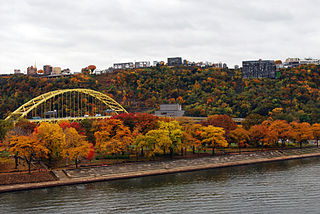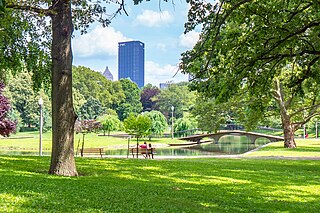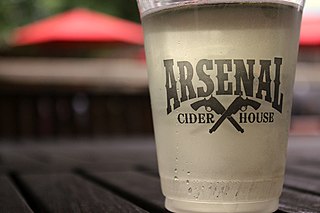
The Carnegie Library of Pittsburgh is the public library system in Pittsburgh, Pennsylvania. Its main branch is located in the Oakland neighborhood of Pittsburgh, and it has 19 branch locations throughout the city. Like hundreds of other Carnegie libraries, the construction of the main library, which opened in 1895, and several neighborhood branches, was funded by industrialist Andrew Carnegie. The Pittsburgh area houses the first branches in the United States.

Point State Park is a Pennsylvania state park which is located on 36 acres (150,000 m2) in Downtown Pittsburgh, Allegheny County, Pennsylvania, USA, at the confluence of the Allegheny and Monongahela rivers, forming the Ohio River.

Lawrenceville is one of the largest neighborhood areas in Pittsburgh in the U.S. state of Pennsylvania. It is located northeast of downtown, and like many of the city's riverfront neighborhoods, it has an industrial past. The city officially divides Lawrenceville into three neighborhoods, Upper Lawrenceville, Central Lawrenceville, and Lower Lawrenceville, but these distinctions have little practical effect. Accordingly, Lawrenceville is almost universally treated as a single large neighborhood.

Allegheny Commons is a municipal park located in Pittsburgh's North Side. The park surrounds the neighborhood of Allegheny Center. Dating to 1867, it is the oldest park in the city of Pittsburgh.

This is a list of the National Register of Historic Places listings in Allegheny County, Pennsylvania.

The Allegheny Arsenal, established in 1814, was an important supply and manufacturing center for the Union Army during the American Civil War, and the site of the single largest civilian disaster during the war. It was located in the community of Lawrenceville, Pennsylvania, which was annexed by the city of Pittsburgh in 1868.

The Elisha Winn House is located at 908 Dacula Road near Dacula, Georgia, United States, 1.9 miles (3.1 km) north of Dacula city limits. The house, currently in Gwinnett County, was built in 1812, six years before the county was established. In 1809, Elisha Winn, Roger Pugh, and Elijah Pugh purchased 7,300 acres (30 km2) on the Apalachee River from a Jackson County tax collector. On December 15, 1818, the Elisha Winn house and the property became part of Gwinnett County. The house is the oldest surviving building in Gwinnett and probably the oldest building in metropolitan Atlanta.

The O'Hara Student Center, formerly the Concordia Club, is a three-story, 18,000-square-foot (1,700 m2) building on the campus of the University of Pittsburgh on O'Hara Street in the Oakland neighborhood of Pittsburgh, Pennsylvania. It is a contributing property to the Schenley Farms National Historic District and the City of Pittsburgh Oakland Civic Center Historic District. The building was acquired by the university in mid-December, 2009. and has since been renovated to house academic and student activity programs.

The Arsenal School is a historic school building in the Lower Lawrenceville neighborhood of Pittsburgh, Pennsylvania. It houses both a middle school, Arsenal 6–8, and an elementary school, Arsenal PreK–5, operated by Pittsburgh Public Schools. The building originally opened in 1932 as a junior high school, with the elementary school addition completed in 1939. It stands on part of the former site of the Allegheny Arsenal.

The Wigman House is a historic American Queen Anne house in the Carrick neighborhood of Pittsburgh, Pennsylvania. It is a City of Pittsburgh Designated Historic Structure.

The Walker-Ewing Log House is an historic, eighteenth century loghouse located in Collier Township, Allegheny County, Pennsylvania. Owned and managed by the Pioneers West Historical Society beginning in the 1990s, the home and land were acquired by the Allegheny Land Trust in 2020 with oversight responsibility for the building's preservation and easement given to the Western Pennsylvania Conservancy.

Arsenal Cider House and Wine Cellar is a small-batch cider manufacturer located in the Lawrenceville neighborhood of Pittsburgh.

Butler Street is a street in Pittsburgh, Pennsylvania which is the main commercial thoroughfare of the Lawrenceville neighborhood. Since the early 2000s, it has become a center for arts, dining, and music, with many local businesses including bars, restaurants, breweries, and specialty shops. It is named for the city of Butler, Pennsylvania, whose namesake was Maj. Gen. Richard Butler of the Continental Army.

The Carol Peterson House is located at 172 46th Street in the Lawrenceville neighborhood of Pittsburgh, Pennsylvania. The house was built in 1886–1887 in the Italianate architectural style, and is named after the architectural historian, Carol Peterson.

The Turney House is a historic house in the Lawrenceville neighborhood of Pittsburgh, Pennsylvania, and a designated Pittsburgh historic landmark. It was built circa 1851 by Lucian B. Turney, a carpenter who also served on the Lawrenceville Borough Council during the 1850s. It was also the residence of Turney's daughter Margaret, who at age 17 was one of 78 workers killed in the 1862 Allegheny Arsenal Explosion, the deadliest civilian disaster during the U.S. Civil War. After the demolition of 184 38th Street in 2011, the Turney House is the only surviving house known to be associated with a victim of the explosion. Another one of Turney's children, Olive, became a successful artist. In 1996, the house was purchased by architectural historian Carol Peterson, who restored it to a period-appropriate appearance.

Naser's Tavern is a historic building in the Lawrenceville neighborhood of Pittsburgh, Pennsylvania, and a designated Pittsburgh historic landmark. It is thought to be the oldest surviving building on Butler Street, the main commercial street in Lawrenceville. The structure was probably built by John Kingan between 1833 and 1846, as the price of the property when Kingan sold it indicates there was already a substantial building on the site. At the time, it was at the edge of the built-up area of Butler Street, which spanned approximately one block on either side of the Allegheny Arsenal. John Naser, a German immigrant, bought the property in 1846 and operated an inn and tavern there which he called "Our House". His son Charles took over the business in the 1870s and expanded the building with several additions, including a second floor which was built sometime between 1893 and 1905. The Naser family sold the building in 1943. As of 2018 it houses a branch of Pennsylvania's state-run liquor store, Fine Wine & Good Spirits.

The Lawrenceville Historic District is a U.S. historic district in Pittsburgh, Pennsylvania, which encompasses the majority of the Lawrenceville neighborhood. The historic district includes 3,217 contributing resources, many of which are rowhouses, commercial buildings, and former industrial properties built between the 1830s and early 20th century. The district was listed on the National Register of Historic Places in 2019.

The Ewalt House was a historic house in the Lawrenceville neighborhood of Pittsburgh, Pennsylvania, and a contributing property in the Lawrenceville Historic District. It was built as a country estate sometime between 1787 and 1840 by Samuel Ewalt, and remained standing after most of the land was subdivided for residential lots in the 1870s. The house was notable as a rare example of an antebellum style Greek Revival house in Pittsburgh, and exemplified the typical pattern of development in Lawrenceville in the mid to late 19th century. In 2019, the building was nominated as a Pittsburgh historic landmark.
Two buildings in Pittsburgh were known as the United States Marine Hospital. They were part of the U.S. Marine Hospital system, which was run by the Marine Hospital Service and its successor the Public Health Service, primarily for the benefit of the civilian merchant marine. The original hospital was located in Allegheny City and was used as a Marine Hospital during 1851–1875, after which it was sold. It was demolished in the late 1880s for construction of the Ohio Connecting Railroad Bridge.
























